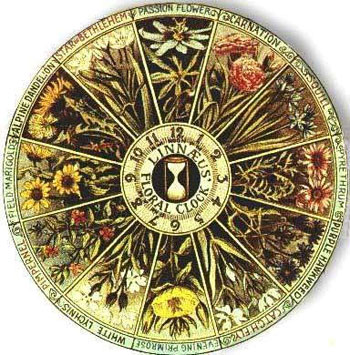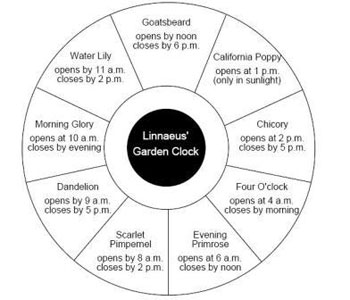How to tell time from flowers with a floral clock
The floral clock is truly enchanting, imagine being able to tell time just by looking at flowers. People who know how this works can leave their wristwatches at home. In the 18th Century Swedish botanist Carolus Linnaeus made observations about a flower bed with blooms that would open at different times of the day. It became popular in the 19th-Century for gardeners to plant 'flower clocks' in which the flowerbeds were laid out in a circle or an annulus to form the clock face. The 'clock face' was divided into 12 segments, each of which contained flowers that either opened or closed in that one-hour time period.

You can try to create flower clock in your garden too.
Flower-clock bed should be placed in the most solar place of your garden.
First, you'll need to select some flowers that open and close at different times (listed below).
Try to find plants that grow well in your area, ones that flower at the same time of year.
Make a small circle (about a foot in diameter) in some outdoor soil.
Plant the flowers in order around the outside of the circle so you can read them like a clock's face.
Divide the circle into 12 sections to represent each hour of the day.
When they bloom, you'll have your own flower clock.
Unfortunately, a flower clock which is both attractive and useful is an impractical proposition. The reason is, many of the flowers look very similar or do not grow well together. Also this type of clock only works on sunny days or on cloudy days. Some plants simply do not open their inflorescence's at all. However, what you can do is choose a few of the day flowers, making a simple display in a smaller bed which will set itself to open and close at significant times of the day. A great example to try in your garden is having an early breakfast tea in the morning or a nice Black Spice Chai tea in the late evening. How fantastic would it be to tell your friends the flowers say it's tea time?
Here is how define the exact time on flowers.
The Biological Clock of Some Flowers:
2 a.m.:
Common Morning Glory (opens)
Night-Blooming Cereus (closes)
3 a.m.
Imperial Morning Glory (opens 3-4 a.m.)
4 a.m.
Yellow Hawkweed (opens)
Dogrose, Chicory, Yellow Goats-Beard (opens 4-5 a.m.)
5 a.m.
Buttercups, Poppy (opens)
Dandelion, Morning Glories, Wild Roses (opens 5-6 a.m.)
6 a.m.
Spotted Cat's Ear (opens)
Flax, Potatoes (open 6-7 a.m.)
7 a.m.
African Marigold, Lettuce, White Water Lily ( opens)
8 a.m.
Mouse-Ear Hawkweed, Scarlet Pimpernel (opens)
African Daisies, Nolana (open 8-9 a.m.)
Dandelion (closes 8-9 a.m.)
9 a.m.
Calendula (Field marigold), Catchfly (opens)
Coltsfoot, Gentians, Sandworts (opens 9-10 am)
Prickly Sow Thistle (closes)
10 a.m.
Common Nipplewort (closes)
Star-of-Bethlehem (opens 10-11 a.m.)
California Poppies (open 10a.m.-1 p.m. only in sunlight)
11 a.m.
Star-of-Bethlehem (opens)
Noon
Goatsbeard, Blue Passion flower (opens)
Morning Glories (closes)
1 p.m.
Carnation (opens)
Childing Pink (closes)
2 p.m.
Afternoon Squill (opens)
Scarlet Pimpernel, Water Lily (closes)
Chicory, Dandelion, Poppy, Potatoes, Sandworts (closes 2-3 p.m.)
Dandelion (closes 2-5 p.m.)
3 p.m.
Hawkbit (closes)
Calendula, Spider plant (closes 3-4 p.m.)
4 p.m.
Purple Hawkweed (opens 4 p.m.)
Four O' Clocks(opens 4-7 p.m.)
Small bindweed, Allyssum (closes)
California Poppies, Cat's Ear (closes 4-5 p.m.)
5 p.m.
Night-Flowering Catchfly (opens 5-6 p.m.)
Chicory, White Water Lily (closes)
Coltsfoot (closes 5-6 p.m.)
6 p.m.
Showy Evening primrose, Goatsbeard, Moonflowers (opens)
White water lily (closes 6-7 p.m.)
7 p.m.
White campion (opens)
Fig-marigold (opens 7-8 p.m.)
Iceland poppy (closes 7 p.m.)
Daylily, Dogrose (closes 7-8 p.m.)
8 p.m.
Night flowering cereus (opens 8-10 p.m.)
Catchfly, Dandelions, Daylilies (closes 8-9 p.m.)
9 p.m.
Flowering Tobacco (opens 9-10 p.m.)

Downloadable Classroom activity: How to build a Flower Clock by Science Museum Of Virginia
Interesting trivia:
A floral clock features in the fictional city of Quirm, in Soul Music, one of the books in Terry Pratchett's Discworld series.